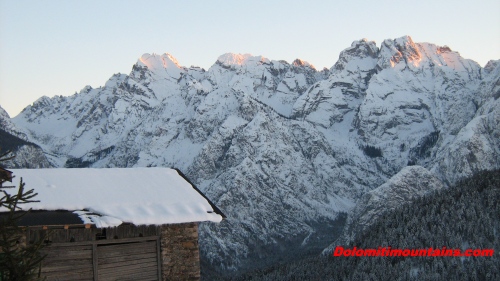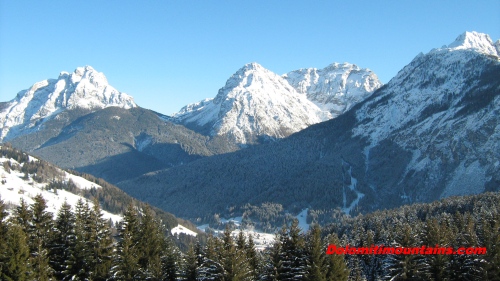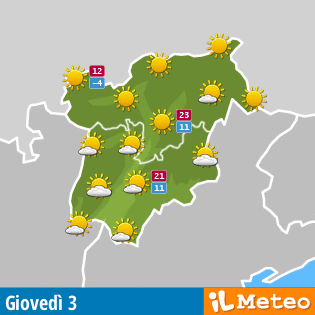Weather Dolomites
Some data about Climate on Dolomites
 |
| Italian |

Weather Dolomites in winter usually presents a minimum of rainfall, which comprises most of the time by snow, whose accumulation depends on the altitude and orography of each valley. In some years, the snowfall may be quite modest, but as usual they are consistency and can sometimes become quite exceptional and accumulates several feet of snow on the ground at only 1.000-1.200 meters, like during the winter 2008-2009. With some exceptions, the more snowy valleys are those closed or winding and those furthest from the Po-Venetian Plain and the Adriatic Sea, where it is rare that the snowfall is converted into rain due to warm winds from the south.
Areas of high snowfall are Zoldo Valley and the area of Falcade in the province of Belluno. The combination of cold temperatures, mostly below zero, and the relative lack of liquid precipitation makes the winter weather very suitable to host winter sports: there are indeed generous contributions of snow, while the shade and stiff night temperatures allow, by a side, to make possible artificial snowing in case of lack of rainfall, and secondly to keep the snowpack, natural or planned.
Weather Dolomites changes in spring and it is frequently observed the continuation of frost as well in fall their expression occurs early in relation to lowland or hill placed at lower altitudes and latitudes. The temperatures of the intermediate seasons are warmer than those in winter. The area has indeed some Dolomite and continental average temperatures in parts of the spring months are higher than winter even more than 13°C, with greater variance in locations on the flat than on a slope.
In any case, according to the altitude, the months of March and November may have features of winter: with frosts, low daytime temperatures, and snowfall. About Weather Dolomites during the intermediate seasons, more than in winter, the temperatures rise as well as rainy days and amount of precipitation. In spring and autumn there are less frequent days of clear skies and fine weather, variability advised to bring clothing of various kinds in order to be ready for warm days and sunny to rainy days, or snowfall, that, except in full summer months, are never entirely out of season.
 |
 |
Weather Dolomites peculiarity
Weather Dolomites is peculiar because the summer is short and characterized by daytime temperatures fairly mild. In recent years, exceptionally warm, there have been spikes in temperature above 30°C in countries with intermediate level as Predazzo in trentino and S. Stefano di Cadore, in the province of Belluno, but similar values are the exception rather than the rule. Dolomite countries, except perhaps in the lowest Agordo as the province of Belluno, maximum summer temperatures are on average less than 25°C, and naturally decrease with increasing altitude.
If, for example, Agordo altitude of 600 meters the average maximum summer temperature is around 24° C, Santo Stefano di Cadore at the building about 900 meters it was approximately 23°C in 1.000 meters Predazzo 21°C to about 1.200 meters in the province of Belluno Sappada it is 19,6°C and 1.600 meters of Arabba near Belluno are 18° C and about 2.230 meters above sea level of the Paganella in the province of Trento is only 12,7°C (source: ENEA Climate Atlas).
Higher altitudes influence Dolomites Climate as temperatures decrease further, and reached greater heights of these mountains can be found average summer a few degrees above zero, or as 3.340 meters of the summit of the Marmolada, where one of the last significant glaciers of the Dolomites survives. The average summer of minimum temperatures are quite cool throughout, and vary from about 11°C Bressanone 560 meters of altitude in the province of Bolzano, decreasing with increasing altitude up to 6 or 7°C or countries like Arabba Mazzin in the province of Trento. So during the summer evenings we recommend you always to have warm clothing. The summer is also one in which occur more precipitation and the more of rainy days.
Overall, the Weather Dolomites is characterized by short summers, fresh, and seldom sultry, from intermediate seasons with appreciable fonts winter, cold and dry winters weather with little precipitation formed by snow and rainfall on annual average decrease with increasing latitude and distance from the sea. This could be the average mountain weather.
